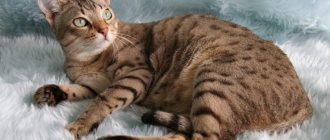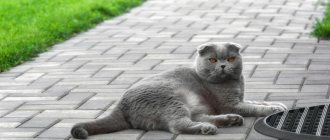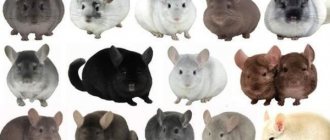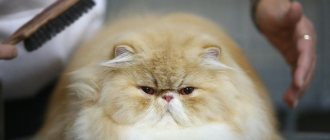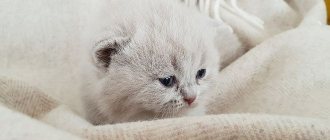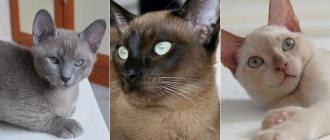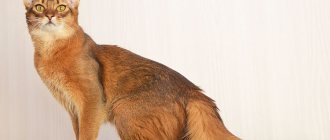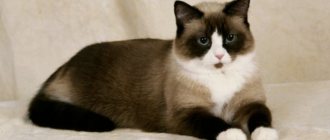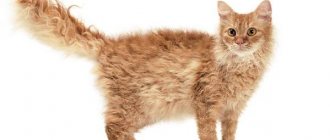What do Siberian cats look like?
Animals of this breed have been known in our country for many centuries. Initially, they were brought to Siberia by Asian traders, and these cats were called Bukhara. They took root in the new place and regularly helped in the fight against rodents. Thanks to merchants, over time the animals settled throughout the country, and later gained popularity throughout the world. They were identified as a separate breed in the 20th century.
Siberian cats are distinguished by their beauty and grace. Photo: endomass/Depositphotos
Siberian cats Siberian cats are medium to large sized animals. Their body is powerful, muscular, with smooth and rounded outlines. Females are usually smaller than males. Moreover, Siberians reach maturity at about five years.
The natural conditions in which the breed was formed left their mark on the appearance of the animals.
Their coat is medium or long, with a double thick undercoat and dense guard hair. Tassels are often noticeable at the tips of the ears, which is why they appear pointed, although they have a rounded shape. The collar on the neck, panties on the hind legs and tail are very fluffy.
There are quite a lot of color options for Siberian cats - solid, tortoiseshell, tabby and others. Eyes also come in different shades - from golden to green and blue. There are also cats with heterochromia, that is, with unequal colors of the iris. Animals with color-point color and blue eyes are distinguished as a special subspecies - Neva Masquerade.
When talking about Siberian cats, they often mention their hypoallergenicity. But according to experts, this statement is not entirely true and has no scientific evidence. Indeed, some Siberians have a reduced content of the Fel d 1 protein in their saliva, which in many cases is the cause of the reaction of the human body. But this cannot be applied to all representatives of the breed, so owners of such pets are not insured against allergies.
- Feeding with natural products
- Meat
- Bird
- By-products
- Fish
- Eggs
- Dairy
- Plant proteins
- Vegetables
- Fruits
- Greenery
- Fats, proteins, carbohydrates
- What can and cannot be given to cats
- Vitamins
- Ready-made feed
- Canned food
- Dry food
- Feeding kittens
5. Nutritional features
Natural food sources are usually not available to the domestic Siberian cat. The owner himself must take care of her diet.
The food bowl should be stable and not too deep. The water bowl can be larger. After eating, be sure to throw away any leftover food and wash all bowls. If you neglect this, your cat may experience an upset stomach or even poisoning.
Siberian cats of light colors (for example, Neva Masquerade) should not be given liver in large quantities, as its consumption causes unwanted darkening of the coat.
The cat should be fed in a strictly designated place (for example, in the kitchen or bathroom). To avoid dirtying the floor, you can lay oilcloth or newspaper under the bowls.
A properly balanced diet is the key to a healthy cat.
Special attention should be paid to feeding your cat. Feeding her only what she wants, or only leftovers, will lead to metabolic disorders. A properly chosen diet contributes to the proper formation of the skeleton, hair growth, normal metabolism in the body, and is also a source of physical strength for the Siberian cat. Portion sizes and food choices depend on the age and condition of the cat.
There are basic rules for feeding Siberian cats:
– the portion size is correct if the cat is moderately well-fed and does not look thin or obese;
– the diet should be sufficiently varied and properly balanced;
– An adult cat’s food preferences depend on what she ate as a kitten. If you feed a kitten one type of food, it will likely grow up to be picky;
– treats that a cat receives between main meals should not exceed 10% of its daily diet;
– you need to feed the cat at the same time, in the same place, always from a clean bowl. Food should be at room temperature;
– It is recommended to feed an adult Siberian cat 2 times a day. The amount of food depends on the cat’s body weight (30–60 g per 1 kg of weight). On average, this is approximately 150–200 g of feed per day;
– the Siberian cat must receive a sufficient amount of nutrients and vitamins;
– the diet of a Siberian cat under the age of 3 years should contain about 60–70% protein, since at this age the body is developing;
– long-term monotonous feeding of a Siberian cat with canned food and dry food can cause the development of various diseases (liver, pancreas, urinary system, etc.), this happens because the Siberian cat is genetically programmed for natural prey (meat). But you can’t feed your cat only meat, this leads to unwanted stress on the liver;
– the cat must be fed with cereals and vegetables;
– Once a week you need to give your cat a boiled egg yolk (can be added to the main food), as it is rich in vitamins and microelements;
– to avoid clogging the stomach with hair, Siberian cats should be given low-fat fermented milk products (
kefir, cottage cheese). These foods are also rich in calcium;
– A bowl of fresh water should always be available. Sometimes, if cats are reluctant to drink water, they are given liquid food. This can prevent metabolic disorders and dehydration;
– the cat should have a bowl of grass – a source of fiber, vitamins and folic acid. The herb helps remove hairballs swallowed while licking the fur.
The diet of a Siberian cat should be quite varied. The cat must be fed meat, fish, vegetables, herbs, dairy products, cereals, and also given nutritional supplements.
Feeding with natural products
Since the Siberian cat is a carnivore, it needs food containing at least 40% protein in the total volume. She needs proteins of both animal and plant origin. Cats benefit from food containing easily digestible fats, which are needed for the synthesis of vitamin D.
In a balanced feed, nutrients and vitamins are present in the quantities required by the animal.
Taurine is very beneficial for Siberian cats. This amino acid is not synthesized by their body. Lack of taurine causes retinal atrophy and blindness, disturbances in the functioning of the nervous system, weakening of the immune system, and leads to the development of urolithiasis. Deficiency of amino acids (for example, arginine and taurine) leads to dysfunction of the reproductive organs.
Meat
Siberian cats can be given all types of meat (except pork), but with a small amount of fat. The most useful is beef with streaks, which should be given 70–100 g daily in minced form. Lamb is given only young and lean. Beef and lamb can be given either raw or cooked. Rabbit meat must be pre-cooked and bones removed from it. It is beneficial for a cat to chew raw meat, as this helps develop its jaw. Raw meat should be washed well, cut into pieces and given to the cat in this form (it is better to first douse it with boiling water).
Bird
Chicken meat should not be given raw; it must be boiled, fried or baked (or at least scalded), carefully removing all the bones. Chicken bones are very dangerous for a cat; their sharp edges can injure her stomach. Cats love to eat chicken necks, this helps remove tartar. Turkey meat can also be given raw in small quantities. Fatty poultry meat (goose and duck) is not recommended.
By-products
By-products that should be given to cats include:
- heart. It should be given boiled, after removing the fat;
- liver. Cats really like it, it contains many vitamins (including A, H, B vitamins), but it is given in its raw form no more than once every 2 weeks. Raw liver acts as a laxative on cats; boiled liver, on the contrary, will strengthen it;
– kidneys (lamb, beef). Before cooking the kidneys, they must first be soaked;
- scar. Cats do not really like tripe, as it is tough and has a specific smell;
- lungs. They are low in calories and nutrients, but cats eat them with pleasure;
– the udder is a slightly fatty product; it is not recommended to give it to a cat often.
It is recommended to give by-products to a Siberian cat no more than once a week.
Fish
A diet consisting only of meat and fish is not very healthy for Siberian cats. They should not be fed raw fish, which contains thyminase. This enzyme destroys vitamin B1, which leads to indigestion and stunted growth. If a cat often eats raw fish, its fur becomes damaged and dandruff appears.
Heat treatment of fish destroys this enzyme, so you can feed your cat only boiled fish (tuna, flounder, cod, etc.).
It is extremely rare to give fatty fish (sprat, mackerel, herring). It is not advisable to feed your cat canned cod liver and pollock.
Eggs
The body of a Siberian cat does not digest raw eggs very well. Raw yolk is added to milk, porridge, vegetable puree, mixed with chopped meat and ground wheat grains. Substances present in raw protein destroy vitamins E and H (biotin), which leads to hair loss and dermatitis. A cat can only be given boiled protein.
Dairy
Milk contains protein, calcium and other microelements. But you should feed your Siberian cat milk in moderation. Very often, adult cats do not tolerate cow's milk (lactose) well. Its use can cause diarrhea and colic in cats. You should give your cat milk only if she tolerates it well, otherwise it is better to feed her with fermented milk products: kefir, cottage cheese (you can add a little whey or egg yolk with ground wheat grains), sour cream, yogurt and cheese (only unleavened varieties, since excess salt leads to many diseases). You should not give curd or cheese curds instead of cottage cheese.
Lush, thick hair is a sign that the cat is fed correctly.
Plant proteins
Plant protein is found in vegetables, mainly legumes. Legumes (lentils, peas, soybeans, beans) are used as additives to the main food, since they are not very well absorbed in the body of a Siberian cat.
Vegetables
Many Siberian cats happily eat boiled vegetables, which are given to them in the form of puree or soup. This way you can cook carrots, beets, cabbage (white, cauliflower, kohlrabi), green peas and much more. Vegetables need to be grated with oil. A Siberian cat should be given at least 2 teaspoons of vegetable puree daily. Some cats also enjoy eating fresh cucumbers and tomatoes.
Fruits
Siberian cats try fruit out of curiosity and also for variety. They can eat apple, grapes, melon and strawberries.
Greenery
Greens are given to cats to cleanse the stomach of hair. It definitely needs to sprout wheat, oats, etc. It is useful to add parsley, dill, lettuce and chopped and scalded nettle to the main food. Parsley and dill are also useful for kidney diseases.
The herb will help cleanse your cat's stomach of fur.
Fats, proteins, carbohydrates
During the growth period, Siberian cats benefit especially from fats. Vegetable oil contains polyunsaturated fatty acids and vitamin E, which increase the cat’s immunity, normalize the condition of the walls of blood vessels and participate in metabolism.
Animal fats also contain a large amount of vitamins, and they also provide the cat with the necessary energy.
Most fats are given to cats in the form of sour cream, butter and margarine. Beef fat or butter is added to the broth. Dairy and animal fats contain phosphates, choline, vitamins A, D and E.
With a lack of fat, cats develop dermatitis, hair depigmentation, hypovitaminosis, and growth retardation. With an overdose of fat, the coat becomes disheveled and dull, and excess weight appears. The cat becomes lazy and lethargic.
Foods rich in carbohydrates are cereals, flour products, oatmeal and corn flakes.
In their pure form, they are practically not digestible by the cat, but they contribute to the effective absorption of the main food.
Slightly fewer carbohydrates are found in vegetables, fruits and berries.
Excess carbohydrates in the diet of a Siberian cat leads to loose stools or diarrhea.
What can and cannot be given to cats
Siberian cats benefit from various cereals. Cats that do not tolerate milk well should cook porridge in water. Cats love oatmeal, buckwheat, semolina and rice porridge.
Flour products should be included in the Siberian cat’s diet in moderation. Cats can be given vermicelli with cheese and vegetable oil. Many cats willingly eat rye bread, which is a source of B vitamins.
Siberian cats should not be given chocolate. It contains theobromine, which is very toxic to cats.
In addition, chocolate contains a lot of fat. You can give your cat some cookies or a piece of sugar. Frequently feeding her sweets, especially in large quantities, leads to tooth decay and obesity.
The presence of various cereals in the diet of a Siberian cat contributes to the renewal and beautiful appearance of its coat.
If a Siberian cat refuses milk and fermented milk products, bone meal should be included in its diet. It can be mixed with various foods. For pregnant and lactating cats, as well as if the cat has fractures, it is useful to give bone meal 1 teaspoon daily. In cases of indigestion, bone meal has a strengthening effect.
Salt should not be added to food intended for feeding Siberian cats. Excess salt leads to kidney disease and hypertension.
Vitamins
In pet stores you can purchase complex vitamin and mineral preparations for all age groups. Cats need them for proper development. They must be given strictly according to the instructions, otherwise, instead of benefit, vitamins will only bring harm.
To grow up healthy, a Siberian kitten needs vitamins
The type of vitamins and their dosage should be checked with your veterinarian. The most useful vitamins are A, D, E, H, and B vitamins.
Vitamin A
. Consuming vitamin A improves immunity and promotes the growth and development of the cat. Thanks to it, the animal’s vision sharpens, it sees in light of any intensity. The cat's fur becomes smooth and shiny. Vitamin A is found in raw beef liver. Excess vitamin A leads to diseases of the spine and limbs. The Siberian cat should be given it ready-made with products of animal origin, since its body is not able to synthesize this vitamin on its own. Vitamin A is rich in egg yolk, fish oil, liver, green vegetables and seaweed.
B vitamins (B1, B2, B6, B12)
. These vitamins are found in liver, milk, brewer's yeast, oatmeal, rye bread and sprouted wheat. They are necessary for the growth of the animal, thanks to them the eyes and skin function normally. Siberian cats have a very high need for vitamins of this group.
Proper nutrition is the key to the health of future offspring
Vitamin B 1 is especially useful. It has an anti-neurotic effect. It enters the cat’s body along with yeast, heart, liver and kidneys. A deficiency of this vitamin can cause seizures and vomiting.
With a lack of B vitamins, coordination of movements is impaired, eczema appears on the skin, the activity of the nervous system is disrupted, and the liver enlarges and begins to function poorly.
Vitamin C.
The Siberian cat does not really need this vitamin. She gets enough of it from the grass she eats to cleanse her stomach.
Vitamin D
Participates in the formation of the skeleton. Cats get vitamin D from butter, milk, egg yolk, liver and fish oil, and from sunbathing. An overdose leads to hardening of blood vessels and the formation of kidney stones.
Vitamin E.
For cats, this vitamin is an antidystrophic agent; it also participates in the formation of muscle tissue, restores reproductive functions, and prevents the occurrence of certain infectious diseases.
With a lack of vitamin E (for example, with frequent feeding of canned food from certain types of fish), inflammatory processes occur on the skin and in the intestines, the functioning of the nervous system and reproductive functions are disrupted. Cats can get this vitamin from liver, yeast, kidneys, egg yolk and vegetable oil.
When feeding raw egg whites, vitamin E is blocked, since the protein contains avidin. Heat treatment destroys avidin, so eggs should only be given boiled.
Ready-made feed
Industrially produced food can be divided into 2 types: canned and dry.
Pet stores offer a wide selection of such food for cats of all age groups. Ready-made food is not only nutritious, but also healthy; it contains a lot of vitamins.
You need to remember that if you feed your cat with ready-made food, there is no need to give it additional vitamins. Everything you need in the right quantity is already contained in industrially produced feed.
Each type of ready-made food makes it possible to sufficiently diversify a cat’s diet and is convenient to use.
Canned food
Canned food is very practical to use. It is indispensable on the road, it is convenient to use when there is no time to cook food from natural products. Modern types of canned food are quite safe to use and save time. But they also have their drawbacks.
Canned food contains aggressive ingredients (dyes, stabilizers, preservatives), which are used so that the product can be stored for a long time.
Some picky cats prefer canned food to food made from natural products. There are general rules when consuming canned food:
– open canned food should not be kept in a warm place;
– to make it easier to remove canned food from the can, you need to shake it before opening;
– giving your cat canned food only for 1 feeding;
– the remaining food should be stored in the refrigerator, transferring it to a glass or plastic container;
– It is necessary to monitor the expiration date of canned food.
Dry food
Dry food is also convenient to take on the road; it does not spoil for a long time even when opened. Many manufacturers create food that is close in composition to a cat’s natural diet.
The use of dry food has a beneficial effect on the teeth of a Siberian cat, preventing the formation of tartar.
Basic rules for eating dry food:
– a Siberian cat eating dry food must drink a lot. This is necessary to avoid the development of urolithiasis. If a cat does not drink enough water, dry food should be excluded from its diet;
– dry food must be selected taking into account the age of the cat, otherwise mineral metabolism may be disrupted.
There are 3 types of dry food:
– economy product.
Cheap, low quality food made from food industry waste;
– medium product.
Average quality food with vitamin and mineral supplements. It is created taking into account the age of the cat;
– premium and super premium products
. High quality food, which contains vitamins, minerals and trace elements necessary for the proper growth and development of the cat. These foods contain special extracts that help reduce the volume and eliminate the unpleasant odor of excrement, as well as prevent gas formation.
If the color is a color point, the content of calcium gluconate in the feed, which contributes to the darkening of the main coat, should be reduced. Red and tortoiseshell colors become more uniform and intense if vitamins and seaweed are added to food. A chinchilla's color will darken if seaweed is added to its food.
Feeding kittens
The health of the kitten depends on the right choice. If a cat for some reason cannot feed the kittens herself (for example, if she has mastitis), their owner must take on this responsibility.
Very young kittens should not be fed cow's milk, as its composition is very different from cat's milk and can cause diarrhea. For normal development of kittens, cow's milk does not contain enough proteins and fats. You can buy cat milk substitutes in pet stores (for example, “CAT-MILK” with the addition of taurine).
A small kitten needs to be fed properly
When feeding small kittens, you need to adhere to a certain schedule:
1st and 2nd weeks: feeding cat milk replacer every 2 hours;
3rd week: feeding cat milk replacer every 3 hours;
4th week: feeding cat milk replacer every 4 hours;
5th week: feeding milk at 00.00 and 14.00, porridge (preferably finely ground oatmeal) with finely chopped meat (better beef) at 8.00 and 20.00. You can add finely chopped vegetables and 1-2 drops of vegetable oil to the porridge. The porridge should be served when it has cooled to room temperature;
6th and 7th weeks: you need to feed porridge 3 times a day - morning, noon and evening. You can add vitamins to the porridge (for example, “Krokha”), strictly following the dosage indicated in the instructions. Milk should only be given if the kitten drinks it with pleasure;
8th week: feeding porridge with finely chopped meat 3-4 times a day.
When purchasing a slightly older kitten, you should not suddenly change the diet to which it is accustomed. You need to ask its previous owner what was included in the kitten’s diet, and at first feed it the same foods, gradually introducing new ones.
The owner should strive to ensure that the cat’s diet is close to natural
The kitten's diet should be balanced, varied and regular. The diet should include meat, fish, vegetables, fruits, dairy products, cereals and cereals. The kitten should receive vitamins and minerals, food should be rich in protein, fats and carbohydrates. Food should be given only in crushed form, not too cold or hot. Your kitten should always have clean drinking water.
Table of contents
What is the character of Siberian cats?
Representatives of this breed of Siberian cats are good-natured, calm and sociable. They easily find a common language with everyone, although sometimes they can be stubborn and willful.
How do Siberian cats get along with adults?
Loyal animals love to spend time in human company. Siberians enthusiastically follow family members around the apartment and accompany them during any activity - from cooking dinner to watching TV or reading.
They often communicate their mood with melodic purrs and other sounds.
Owners of cats of this breed also note that Siberians have a great sense of people’s moods and are always ready to “support” a sad owner.
How do Siberian cats get along with children?
Sociable and affectionate, these animals willingly frolic with their young owners and are active in games. In addition, they often sleep next to their children’s beds, not wanting to be separated from them for a long time.
However, in order for communication to develop without conflict, the child needs to be explained the rules for handling animals. If the young owner perceives him as a toy, the cat may show his claws, defending his safety.
How do Siberian cats get along with other pets?
Siberians often feel comfortable in the company of other purrs and even dogs. If, at first, after the arrival of a new pet, conflicts arise in the house, you just need to be patient and try to help the pets get used to each other.
Character
The Siberian cat has a calm and friendly character, which makes the cat a good companion. Representatives of this breed are very sociable and become strongly attached to their owner. This feature has its pros and cons:
- If you are unable to provide your cat with the attention it deserves, your pet will be bored.
- On the other hand, a cat can become your most faithful friend who will accompany you for the rest of its life.
Siberians are often compared to a dog: the cat is distrustful of strangers, can defend its territory, and is wary of loud extraneous sounds.
The Siberian cat perceives other animals in the apartment as competition. He shows calmness and patience towards children, loves to play pranks and play with them.
The breed is distinguished by a sharp mind; they are smart enough to quickly perceive new information. Thanks to this, cats easily learn the rules of a new home.
What living conditions do Siberian cats require?
Make sure your pet is comfortable in your home.
Photo: Dizfoto/Depositphotos Siberian cats are very active, agile and agile Siberian cats. They willingly play with different toys and enthusiastically explore everything in the house. Therefore, it is worth making sure that the neglected pet has something to do.
Especially for a cat, you can install a play complex with posts, shelves and ladders. And the Siberian will definitely be delighted with soft mice, balls and other objects that he can hunt for to his heart’s content.
This playfulness persists in animals throughout their lives.
The pet will need its own place to rest. This can be a separate soft house, basket or bed. There the cat will be able to sleep and just spend time alone with itself.
It is advisable to install special protective nets on the windows. Thanks to them, the cat will not be able to fall out if it decides to catch a leaf, butterfly or bird flying by. Protection will be needed even on the windows of the first floors. Thanks to it, the animal will not be able to get outside and be in danger if left unattended.
How to choose a kitten
Siberian kitten with mom
When choosing a Siberian kitten, it is worth remembering that this breed is distinguished by a variety of colors. Many unscrupulous sellers take advantage of this and, under the guise of Siberian ones, sell kittens of unknown origin, so it is better not to buy from a Siberian.
For a purebred Siberian kitten, you should go to a nursery or a breeder with a good reputation. It is better to purchase babies who are already 3.5 months old. They should be moderately well-fed, well-groomed, active, and curious. The kitten's fur should be shiny and its eyes should be shiny. It is advisable that the baby you like has a reciprocal feeling towards you. To check this, hold him in your arms - he should feel comfortable, not struggle or worry.
A kitten at the age of 3-4 months almost completely corresponds to the standard of the Siberian breed, but there are some nuances. His fur still remains soft, “baby”, his ears may be set a little closer than they should be - this should change with age. The baby must have documents with information about the vaccinations given to him, and you must also be given the pedigree of the animal.
If you need a kitten for breeding or you want your Siberian to participate in exhibitions, you need to buy a baby in clubs that are members of one of the official international felinological organizations, for example, WCF, FIFe. In independent clubs, approaches to breed standards are often also “independent”.
How to feed Siberian cats
The easiest diet option for a pet is ready-made complete food from well-known brands. Such food contains useful and nutritious substances that animals need. You can choose from dry and wet food (pouches, canned food). There are also special diets designed for the period of pregnancy and lactation or intended for animals with various allergies and other diseases.
An alternative to ready-made food is natural food consisting of offal, meat and vegetables. When creating such a diet, you need to take into account all the needs of the cat’s body so that the pet’s health does not suffer. But you shouldn’t feed a Siberian cat with leftovers from dinner or other food from the human table. This will not bring any benefit, even if the pet really asks.
Spicy, salty, spicy, smoked and sweet foods are especially dangerous for animals.
When choosing a diet, first of all you need to find out from the breeder what kind of food the kitten is accustomed to, and at first do not change its diet. Over time, if there is such a need, you can gradually switch to another option. If you do this abruptly, the pet may simply refuse to eat or have digestive problems. Another important point: the animal should always have access to clean drinking water.
Make sure your Siberian cat does not overeat. Siberian cat diet. Representatives of this breed are often prone to gaining excess weight, which can cause them to develop arthritis, diabetes, as well as liver problems and other diseases. In addition, there is a high probability of reducing life expectancy by a couple of years. Overweight cats are less active and mobile, which is also not good for them.
Care and feeding
When buying a kitten, you need to ask the owner what the baby was fed after birth and at first the diet should be familiar, then gradually expand it.
- The cat needs its own dishes for food and water. Bowls should not be “human dishes”; buy them at a pet store.
- The preferred materials are plastic or stainless steel.
- They need to be washed separately from the family’s dishes.
- The kitten should always be given food in the same place.
- The frequency of feeding the kitten is 6 times a day for the first 3 months, then up to 5 times. As the baby grows, there is no need for frequent feedings. It is enough for an adult animal to eat twice a day.
The range of meat foods is wide: all types of meat and poultry, with the exception of turkey and sea fish. Cottage cheese is also very useful. You can give porridge with the addition of egg yolk or purchase ready-made milk formulas recommended by veterinarians for artificial feeding of kittens at specialized pet stores.
You cannot feed your cat economy class food! This can lead to serious illness!
"Toilet corner"
At the moment, there is a wide variety of cat litter boxes available: without bars and with them. Trays in the form of pallets or closed houses. The tray should be placed under the bedside table or in your bathroom, and the cat should always have access there. If the kitten is already accustomed to a particular tray, then you need to use the same one. The cat litter box needs to be cleaned regularly and thoroughly. Hot, soapy water and chlorine-containing disinfectants work best for this.
Strong chemicals such as resorcinol and its derivatives, creosote, and carbolic compounds pose a threat to cats and should not be used to clean litter boxes.
After using detergents, the tray must be thoroughly rinsed and dried.
How to care for Siberian cats
Siberians do not need complex care Caring for Siberian cats, because they can take excellent care of themselves in most cases. But if you notice that your pet’s fur is becoming tangled and mats appear in it, it would be a good idea to help him.
Siberian cats take care of their luxurious coat themselves. Photo: tania.wild/Depositphotos
Seasonal shedding in Siberian cats lasts approximately 10 days. During this period, animals need to be combed daily: this will speed up the renewal process and maintain an attractive appearance.
The rest of the time, Siberian cats do not leave a lot of fur throughout the apartment, although there are exceptions.
As for bathing, it is important when preparing for exhibitions and if the pet gets very dirty, for example, while playing outside. Usually this procedure does not cause problems if the kitten is accustomed to it from a young age.
Trim nails that are too long as they grow. Also keep an eye on your eyes and ears. If necessary, wipe them with lotions that can be purchased in specialized stores. Pay attention to brushing your teeth - doing this a couple of times a week is enough.
Kitten nutrition: what do they eat?
Ideally, kittens should remain near their mother for up to two months. But if the owner, for some reason, decides to feed the little fluffy himself, then he should know that in the first weeks of life it is permissible to feed only a cat's milk substitute.
First 2 months
For the first two weeks of life, feeding occurs every two hours. In the third week - every three hours. Fourth week - every four. Starting from the fifth week, milk replacer can be alternated with cereals.
By the end of the first month of life, you can include meat in the kitten’s diet, which must be finely chopped. You can start adding vegetables and a few drops of oil to the porridge. Food should be at room temperature. By two months, the baby's diet should be quite varied.
From 2 to 4 months
From two to four months, new products are introduced gradually. It is important to especially carefully monitor the balance of your diet, since right now the most active growth is taking place. We must remember that kittens need proteins, calcium, and vitamins. It is also necessary to ensure that there are no harmful products in the baby’s food basket.
What do Siberian cats get sick with?
Representatives of this breed are prone to certain diseases. Diseases of Siberian cats, in particular, are predisposed to cardiomyopathy, arterial thromboembolism, polycystic kidney disease, and urolithiasis. Animals can also suffer from stomatitis and gingivitis, and be exposed to infections and parasites.
This does not mean that your pet will certainly have all these diseases. However, your cat's health needs to be closely monitored.
And for any changes in behavior and mood, it is advisable to seek advice from veterinarians. For example, alarming symptoms may be decreased appetite, lethargy and drowsiness, aggression or depression, hair loss, the presence of tartar, bad breath, and more. Particularly dangerous are problems with urination or breathing, eye damage, excessive weakness, head shaking and more.
Do not forget that timely diagnosis will help avoid complications and health problems.
Getting to know your pet
Before we move on to a description of living conditions, care and nutrition, let’s talk about the characteristics of the Siberian cat breed.
Description and standard
This breed has a rather large and developed body: cats gain weight up to 6 kg, males are much larger and can weigh up to 12 kg. Size is the main distinguishing feature of the breed.
It has large paws, which differ from other breeds by the presence of tufts of hair between the toes. The forelimbs are somewhat shorter than the hind limbs, which gives the animals agility. The head is round and rather large, the muzzle is trapezoidal. The ears are wide at the base, slightly rounded at the ends, with small tufts.
The breed is classified as semi-longhaired. The undercoat is very thick and soft. The outer hair is shiny and flowing, has water-repellent properties, and has a hard texture. The back surface of the limbs and the abdomen do not have integumentary hair.
In the breed there is no clear connection to coat color - it can be different. The standard coat color is black and gray. Color point, white, marbled, silver, black brindle or spotted are also popular.
Important! Breed standards do not allow lilac and chocolate colors.
The eyes are oval-shaped, large, slightly slanted and widely spaced. Their color can range from yellow to green and, as a rule, harmonizes with the color of their coat. In color point colors, the eyes are always blue. White “Siberians” have both blue eyes and different colors.
Average life expectancy is from 13 to 17 years.
Character traits
Siberian cats are moderately affectionate and loyal, quite playful, intelligent and show interest in everything around them. At the same time, they have a pronounced individuality and independence, which is typical for most felines. Like dogs, the Siberian cat recognizes only one person as its owner.
Like no other breed, they exhibit strong hunter abilities and predatory habits. They love to conquer various heights. The owners of these cats note that they are partial to water, often throwing various things into containers with liquid and observing the fluctuations of the water.
Siberian cats remember their nicknames well and always respond to them. They are also sensitive to the well-being and mood of the owner.
When choosing a pet, you should very carefully study the characteristics and requirements for keeping different breeds - Scottish Fold, Bengal, British, Maine Coon - weigh everything in detail and make the best choice.
What to look for when buying a Siberian cat
First of all, decide on your plans for your pet, because its cost will largely depend on this. The most budget option is Siberian pet class cats. These are pets for the soul. They have no chance at exhibitions due to minor deviations from standards, although this does not affect the health of the animals in any way.
For breeding, choose kittens from the “breed” class. And for participation in exhibitions and potential titles - “show”. Such Siberian cats have every chance of receiving the highest marks from judges.
Consider all the points when choosing a kitten. Photo: endomassа/Depositphotos
Of course, before buying, you should look at the kitten itself. He must be well-groomed, active, playful, developed for his age and moderately well-fed. Make sure that the future pet responds normally and does not show aggression.
You also need to evaluate the conditions of its detention and make sure that all vaccinations required by age have been completed.
When purchasing a kitten, documents are also given to the new owner along with it. These include a veterinary passport and birth certificate, as well as a purchase and sale agreement. Based on the metric, you can later obtain a pedigree.
It happens that kittens are bought without documents at all, for example, through websites with advertisements or on the market. But then you will not be able to be sure of his heredity and health, and you will hardly be able to contact the seller for advice. If this is your case, first of all give the animal a veterinary passport and all the necessary vaccinations.
It will not be possible to obtain a pedigree for such a Siberian cat, since there is no information about its ancestors. However, if the animal “very much resembles” a purebred animal, but this is not confirmed by anything, you can contact one of the clubs - and with a positive conclusion from experts, the pet will be given a certificate of compliance with the breed.
Major diseases and nutrition
Siberians can be proud of their good health. They do not have certain genetic diseases. However, living with a person left its mark - Siberian cats began to overeat.
Recently, they often suffer from obesity. In this case, it is necessary to transfer the pet to proper and dietary nutrition. Remember that an adult animal should eat no more than 200 g of food per day.
Like all other animals, Siberian cats are susceptible to dental diseases. Therefore, the diet should always include dry food, which prevents the formation of tartar. An excellent option is Royal Canin ORAL Sensitive 30.
Siberians can also suffer from parasitic diseases. They are most often observed if the cat is completely on a natural diet. Here you need to consult a veterinarian and switch to a mixed diet.
